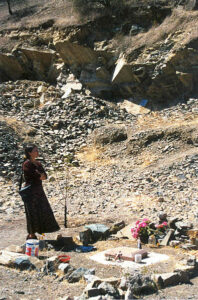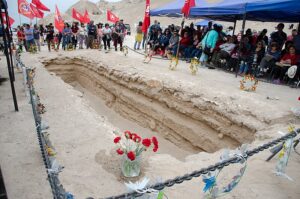November 30th 1978, a team of members of the Vicaría de la Solidaridad (Vicariate of Solidarity) and associates head towards the abandoned mines in the commune of Lonquén to corroborate the testimony of an elderly man from the area who reports having found human remains in the abandoned lime kilns. Once there, the lawyer, González, makes his way through the rubble at the base of the kiln when suddenly a human thorax falls on him. Slowly but relentlessly, a mixture of bones, clothing, lime and stones emerges from the rubble. “Pieces of yellowish skulls with traces of scalp; loose, black hair, torn clothing among which a pair of blue jeans and a man’s vest can be recognized” are the words with which one of the team members would describe the findings. They are the remains of 15 men whose traces got lost after they were detained in October 1973, shortly after the military coup. When interrogated the policemen claim that the 15 men died by armed confrontation, but for the prosecutor these testimonies do not match the facts, there are too many inconsistencies. The seven officers involved in the kidnapping are declared guilty of the crime of homicide, but due to the amnesty law approved a few months prior, the case is dismissed, a strong setback for the families of the victims. This is the beginning of never-ending hope and despair: Contrary to what the civil-military government officially claims, the missing detainees exist and, as in this case, may have died in strange circumstances whilst their bodies still demand to be found.
The year 1973 was a frenetic time for Chile. A social and economic crisis shook the country, putting the continuity of President Salvador Allende’s government in jeopardy. In June, Lieutenant Colonel Roberto Souper and his followers tried to overthrow the government by surrounding the palace of La Moneda with military vehicles. The tanquetazo, however, would not succeed due to the rapid intervention of a group of military supporters of the government, including Carlos Prats and Augusto Pinochet. In one of the great ironies of history, it was precisely Augusto Pinochet who, on September 11 of the same year and after refusing any kind of negotiation, would give the order to bomb the palace of La Moneda, inaugurating 17 years of civil-military dictatorship. During this period Chile suffered a profound wave of economic, social and cultural changes. The dictatorship had a strongly authoritarian model and was characterized by significant limitations on personal freedoms, the prohibition of political parties and the dissolution of democratic institutions. It was all part of an erratic fight against communism and everything that remotely resembles it. In practice, all the above translated into systematic violations of the human rights of the Chilean people and in particular of political opponents. Following the United States’ National Security Doctrine, the military considered themselves to be in an open war against opponents of the regime. It was in this context that various repressive policies were conceived of and applied with cruelty. Organizations such as the DINA (National Intelligence Directorate) systematically engaged in the persecution, kidnapping, torture, forced exile and murder of political opponents, all under the auspices of the new government. The first years of the dictatorship were marked by a wave of arbitrary arrests, raids, armed confrontations and even acts of terrorism and murder both inside and outside the country. In this context, countless summary executions of political prisoners were also carried out in military facilities throughout the country.
 A year after the discovery in the Lonquén kilns, more human remains were found in Yumbel and Mulchén. In both cases, it was proven that army personnel had executed arbitrarily detained people. In Yumbel, a group of soldiers had hidden the bodies in a field close to the execution site, but after wild animals began to dig up the bodies, they decided to move some of the remains to the Yumbel cemetery under the cover of darkness. In Mulchén, some of the victims were buried at the execution site, while others were thrown into the river and were later rescued and buried by locals. The visiting minister managed to find the burial, but they soon realized that the bodies had been removed: only some fragments were left at the scene. After the discovery of the Lonquén kilns the military government trembled and Pinochet himself ordered the operation Retiro de Televisores: a procedure that consisted of returning to the places of illegal burial, unearthing the bodies and destroying them. In an omen of what would happen in Bosnia and Herzegovina more than 20 years later, victims of the Chilean dictatorship disappeared twice. Their remains were exhumed and some of them transferred to other locations, but those that were not moved were instead dynamited, burned or thrown at sea with the aim of making them unrecoverable.
A year after the discovery in the Lonquén kilns, more human remains were found in Yumbel and Mulchén. In both cases, it was proven that army personnel had executed arbitrarily detained people. In Yumbel, a group of soldiers had hidden the bodies in a field close to the execution site, but after wild animals began to dig up the bodies, they decided to move some of the remains to the Yumbel cemetery under the cover of darkness. In Mulchén, some of the victims were buried at the execution site, while others were thrown into the river and were later rescued and buried by locals. The visiting minister managed to find the burial, but they soon realized that the bodies had been removed: only some fragments were left at the scene. After the discovery of the Lonquén kilns the military government trembled and Pinochet himself ordered the operation Retiro de Televisores: a procedure that consisted of returning to the places of illegal burial, unearthing the bodies and destroying them. In an omen of what would happen in Bosnia and Herzegovina more than 20 years later, victims of the Chilean dictatorship disappeared twice. Their remains were exhumed and some of them transferred to other locations, but those that were not moved were instead dynamited, burned or thrown at sea with the aim of making them unrecoverable.
The military dictatorship came to an end on 11th March 1990. In a climate of hope many overcame their fear and dared to speak, giving information to different organizations such as the Vicaría de la Solidaridad or the National Commission of Truth and Reconciliation. The first discovery after the dictatorship was the Pisagua mass grave, located in a cove converted into a concentration camp. The dry climate had protected the bodies of 20 people

Fosa común del Cementerio de Pisagua durante homenaje el año 2018.
who until then had been considered missing, allowing their subsequent identification. Pisagua, however, is an exception: it is the only case in which investigations have allowed complete and well-preserved bones to be found. In all the other cases the remains had been removed and destroyed to prevent investigations. An emblematic case of complete disregard towards the dead can be found in Calama, where the information provided by a witness allowed the identification of the location where the victims of the Caravana de la Muerte had been buried. However, the investigation would reveal that the bodies were removed and disintegrated using heavy machinery. Only a few teeth, pieces of cloth and a little finger were found resulting in the identification of some of the victims. In a demonstration of superhuman effort, some relatives of the victims continue to wander around the most arid desert in the world with their heads bowed, in the hope of finding another clue that would enable them to identify their loved ones.
The first commission of truth and reconciliation, the Rettig Report, used the term “detenidos desaparecidos” referring to persons who were detained by law enforcement officers or persons in their service, the latest of which suggests that they were detained, and with the authorities denied having detained them, or declared having released them, provided other unsatisfactory explanations or simply remained silent. In 2023 the Plan Nacional de Búsqueda Verdad y Justicia (National Plan for the Search for Truth and Justice) was presented, a public policy instrument that sought to advance both the fulfilment of the international and domestic obligations of the Chilean State regarding the search, identification and restitution of victims of enforced disappearance. The specific objectives of the national search plan are: (i) to clarify the circumstances of the disappearance or death of victims of enforced disappearance and their whereabouts; (ii) to guarantee access to information and participation of family members and society in the search processes for victims of enforced disappearance; (iii) to implement reparation measures and guarantees of non-repetition of the commission of the crime of enforced disappearance. According to official data, of the total of 1,469 people who were victims of forced disappearances, the remains of 307 people have been found, identified and returned to their families. There is a universe of 1,162 people whose whereabouts remain unknown.
The recommendations of the two truth and reconciliation commissions have significantly contributed to shaping public memorialization policies in Chile and to orienting their focus towards historical recognition, the establishment of responsibilities, social reconciliation and prevention of atrocities. However, there are various key issues that remain pending and there have been clear limitations to achieve these objectives. Measures such as the Amnesty Law of 1978, statutes of limitations and the fear of facing military authorities have contributed to maintaining a certain level of impunity among the perpetrators. Initiatives that allow memorialization efforts to relate and interact with other areas of transitional justice have seen their potential diminished by the lack of coordination between the different institutions. For example, by recognizing memorial sites as national monuments and pigeonholing them into an existing category, Chilean legislation does not consider the particular characteristics that sites and memorials possess, ignoring their preventative, commemorative, and above all, probative potential, since archaeological evidence and the financing of forensic investigations in general can serve to provide evidence necessary to satisfy justice in matters of human rights. Other initiatives, such as the Archivos de la Memoria en Chile (Archives of Memory in Chile), have identified and protected the material and immaterial heritage related to human rights violations during the military dictatorship with the aim of contributing to the construction of historical memory in Chile. However, it is not clear whether the probative value of this information is explored or to what extent it is captured by other institutions or organizations that have executive mandates to investigate human rights violations. Recognizing the value of a comprehensive approach to these type of investigations, the national search plan matrix established a plan of collaboration with different actors and institutions in order to meet its fundamental objectives, but it is too early to evaluate the effectiveness of such a promising approach.
In March 1980, the new owner of the Santa Marta estate dynamited the Lonquén kilns, irreparably affecting what had become a pilgrimage site. In 1998, the Metropolitan Solid Waste Company proposed installing a dump on the site, unleashing the indignation of the victims’ families and human rights defenders. In response  to the complaints from citizens and families, the Ministerio de Bienes Nacionales (Ministry of National Goods) acquired the site in 2004 to guarantee its preservation. Today, the site that uncovered the truth about the disappeared detainees of the military dictatorship is recognized and protected as part of the national heritage. Despite the efforts, there are more than a thousand bodies still demanding to be found. Many of them were destroyed or hidden in locations where we may never find them.
to the complaints from citizens and families, the Ministerio de Bienes Nacionales (Ministry of National Goods) acquired the site in 2004 to guarantee its preservation. Today, the site that uncovered the truth about the disappeared detainees of the military dictatorship is recognized and protected as part of the national heritage. Despite the efforts, there are more than a thousand bodies still demanding to be found. Many of them were destroyed or hidden in locations where we may never find them.
The military government did a remarkable job of getting rid of this evidence, but they may have never thought that the endless search itself would become a weapon of the opposition, a shared identity among those they tried to silence.
“They were thrown at sea and did not fall into the sea, they fell on us”,
but even if their bodies shattered, their absence has become an overwhelming presence.
Diego Renato-Nunez







